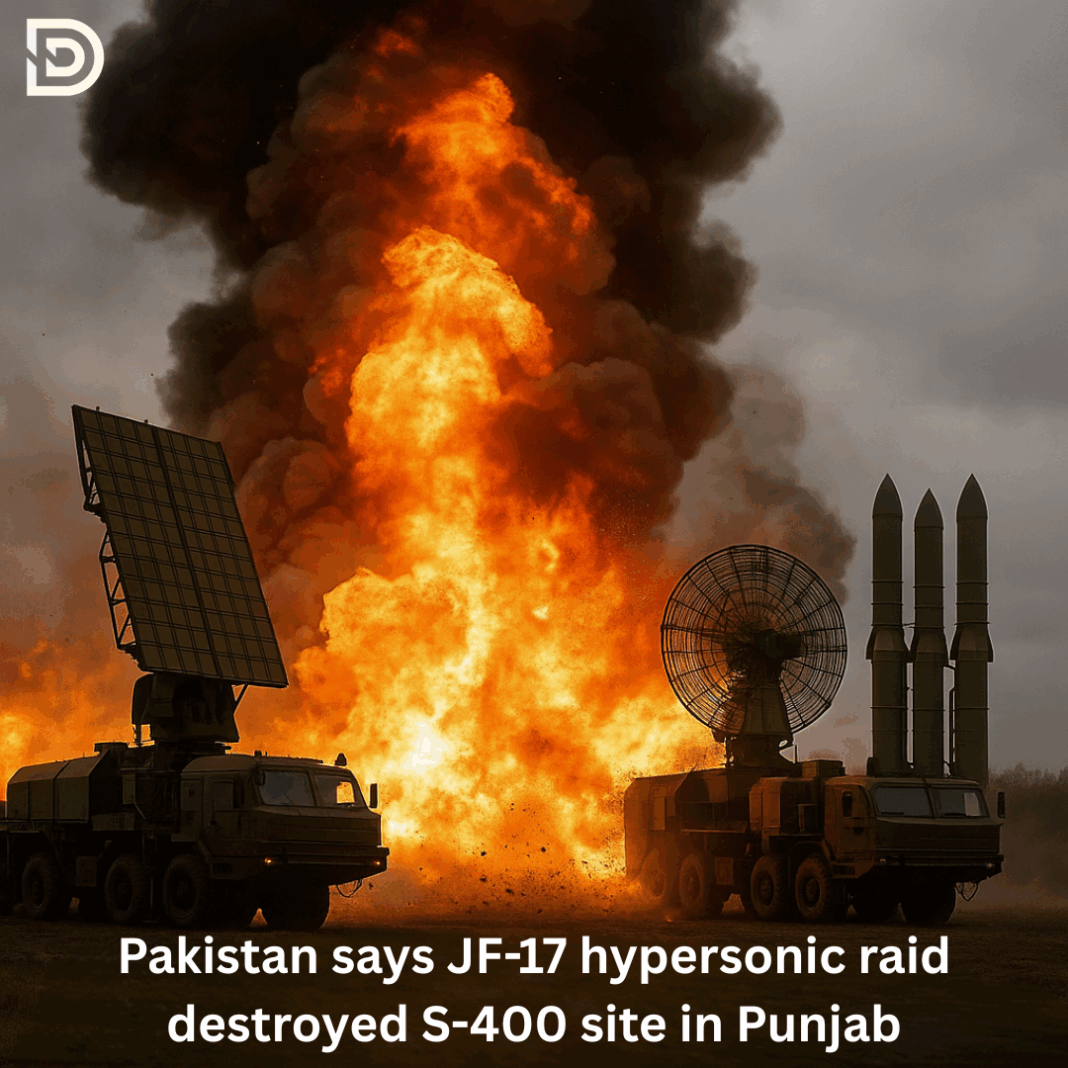On Saturday, Pakistan’s military announced that it had carried out a major aerial offensive against Indian military targets in Punjab.
Pakistan Announces Major Airstrike in Punjab
The main highlight of the announcement was the claim that the Pakistan Air Force (PAF) had successfully destroyed an Indian S-400 Triumf air defense system stationed in Adampur. The S-400 system is one of India’s most sophisticated defense platforms, designed to intercept and destroy incoming aerial threats, including aircraft, drones, and missiles.
The attack was reportedly conducted under an operation named “Bunyan-ul-Marsoos.” According to Pakistan’s military media wing, the Inter-Services Public Relations (ISPR), the strike was launched using hypersonic missiles mounted on JF-17 Thunder fighter jets. These jets are jointly manufactured by Pakistan and China. The ISPR stated that the strike was a “calibrated, coordinated, and precise response” to what it described as Indian missile attacks on Pakistani soil in recent days.
The S-400 system, developed by Russia, is capable of engaging targets at distances up to 400 kilometers. Each system includes command posts, radar units, and multiple launch vehicles.
India had procured five S-400 units in a $5.43 billion deal with Russia. If Pakistan’s claims are accurate, the destruction of one such system represents a significant blow to India’s strategic air defense capabilities. Reports also suggested that multiple military installations were targeted in this operation, not just the S-400 site.
In a televised statement, Pakistan’s ISPR stressed that this was a retaliatory strike and that they had exercised maximum precision to avoid civilian casualties. They also claimed that the destruction of the S-400 installation was confirmed by intelligence sources and aerial reconnaissance.
Falasteen-2 Hypersonic Missile Hits Israel’s Top-Secret Sdot Micha Base in Major Escalation
India Denies Claims, Reports Limited Damage
Shortly after Pakistan’s announcement, India responded with an official statement from its Ministry of Defence. The Indian government denied the destruction of the S-400 system, stating that the air defense batteries in Adampur remained fully operational. According to Indian military sources, the Pakistani airstrikes did target multiple airbases, but the resulting damage was limited and did not compromise major military infrastructure.
An Indian Air Force (IAF) spokesperson said that “the attempted incursions were repelled,” and any missile damage was largely contained to peripheral zones of the affected airbases. The spokesperson further added that India’s forces were on high alert and that all strategic systems, including the S-400, remained functional.
Following the strikes, India launched what it described as “precision retaliatory attacks” on military targets across the border. According to Indian media reports, these counterstrikes focused on radar stations, artillery depots, weapons storage sites, and command-and-control centers located in Pakistan-administered Kashmir and other areas. Indian officials asserted that the action was necessary to eliminate immediate threats and secure national airspace.
India also refuted Pakistan’s claim of using hypersonic missiles, stating that the PAF inventory does not include any confirmed hypersonic weaponry. Indian defense analysts raised doubts about the authenticity of Pakistan’s strike footage, claiming that the visuals released so far do not clearly confirm the destruction of an S-400 unit.
Russia’s 5th Yasen-M Submarine Armed with Hypersonic Missiles Sparks Tensions
Escalating Tensions Between Nuclear-Armed Neighbors
This exchange marks one of the most intense escalations between India and Pakistan in recent years. Tensions began rising sharply after a terrorist attack occurred on April 22 in Indian-administered Kashmir, which killed 26 civilians, including several tourists. The Indian government blamed Pakistan-based militant groups for the attack. Pakistan denied any involvement.
Since then, both countries have engaged in military retaliation. India conducted air raids across the Line of Control (LoC), followed by missile strikes. In response, the neighboring country launched its own missile and air attacks, including the latest airstrike on Adampur. Both sides have accused each other of targeting civilian areas and escalating the situation further.
Local media from both countries have shown visuals of displaced families, damaged buildings, and emergency hospital wards. Reports indicate that dozens of civilians have been injured, and schools in border regions have been closed indefinitely. There are also reports of temporary evacuation orders in sensitive zones.
Russia’s 5th Yasen-M Submarine Armed with Hypersonic Missiles Sparks Tensions
The international community has reacted with concern. Global powers including the United States, China, Russia, and members of the G7 have issued appeals for de-escalation. They have urged both countries to pursue diplomatic channels and avoid actions that may lead to a larger conflict. International observers fear that continued escalation may lead to wider instability in the region.
Despite mutual denials and counterclaims, tensions between India and Pakistan remain high. This conflict between two nuclear-armed neighbors has created significant alarm across South Asia. While the situation continues to develop, the risk of miscalculation remains a matter of serious concern for all stakeholders involved.

